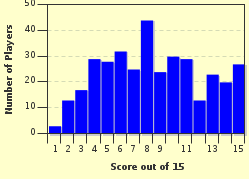Quiz Answer Key and Fun Facts
1. Who represented Britain as High Commissioner of South Africa at the time of the Zulu War?
2. Who was the Zulu King at the time of this war?
3. After getting no response regarding an ultimatum delivered to the Zulu leader, British forces led by Lord Chelmsford invaded Zululand in January 1879. On January 22, 1879, Lord Chelmsford decided to split his forces and move out seeking the Zulus.
Who was placed in charge of the encampment near Isandlwana during Lord Chelmsford's absence?
4. Following their victory at Isandlwana approximately 4000 Zulu reserves raided a nearby garrison at Rorke's Drift. How long did the attack on Rorke's Drift last?
5. All of the men listed below were awarded the Victoria Cross for the defense of Rorke's Drift except for one. Who is the exception?
6. During the Zulu War there was another mission station besieged. What was the name of the station?
7. How long did the siege of Eshowe last?
8. During the course of the war all of the following weapons were used by the British except for one. Which on the list was not used during the Zulu War?
9. What was the name of the traverse Lieutenant-Colonel Redvers Henry Buller's troops had to pass through during their retreat at Hlobane?
10. What battle is thought to have been the "turning point" of the war for the British?
11. Since the start of the Anglo-Zulu War what was Britain's main objective?
12. Following the relief of Eshowe, after the Battle of Gingindlovu, what became of the mission?
13. Near the end of the Anglo-Zulu War who did Lord Chelmsford find out was being sent to replace him?
14. Looking for a quick end to the Anglo-Zulu War, before his replacements arrived, Lord Chelmsford relaunched another invasion into Zululand in June 1879. What exiled heir to a European throne was killed on June 1, 1879 while part of a reconnoitering party?
15. What was the last major battle in the Anglo-Zulu War?
Source: Author
Gargoyle007
This quiz was reviewed by FunTrivia editor
bloomsby before going online.
Any errors found in FunTrivia content are routinely corrected through our feedback system.


